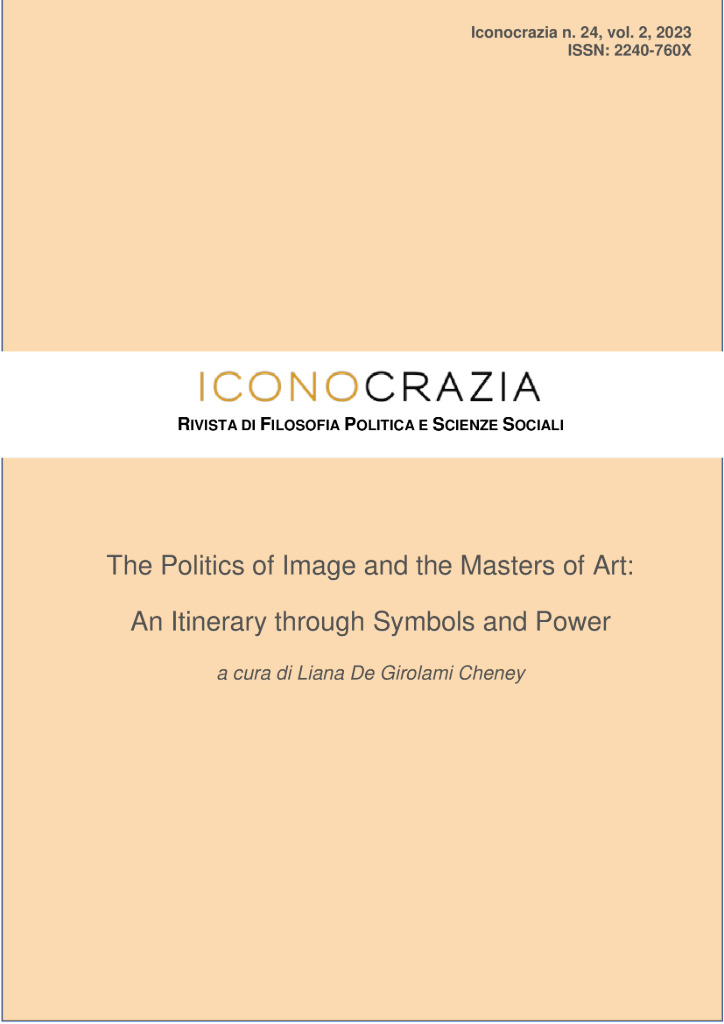Raphael at Court, but Not Altogether of It
DOI:
https://doi.org/10.15162/2240-760X/1864Parole chiave:
Stanze, Raphael, Andrea Mantegna, Baldassare Castiglione, Apollo, ParnassusAbstract
Raphael’s capacity to thrive at court stands out in an age of manners and reflections on manners. His reputation as a perfect courtier has been burnished by his association with Baldassare Castiglione, whose evocation of “the perfect courtier” was one of the most influential books of the Cinquecento and whose portrait by Raphael seems to embody the qualities outlined by Castiglione himself. Castiglione’s Book of the Courtier may represent a shift to self-conscious reflexivity in a long history of positive and negative writings on courts and courtiers. Nevertheless, it emerged in a culture used to visual representations of court life, from images of Mary as Queen of Heaven to more secular subjects, such as Mantegna’s Camera degli Sposi or Signorelli’s Court of Pan. In the Stanza della Segnatura, Raphael painted the court of Apollo on Parnassus with attendant beautiful women and talented and eloquent men (also women), as in Castiglione’s ideal court. Yet in the Stanza, there are indications of Raphael’s capacity for sly and witty subversion of the overarching epideictic purpose; in this, too, perhaps, he was a perfect courtier.Riferimenti bibliografici
Bader, G. (2013). “Whatever Happened to a Pauline Text? 2 Cor.3.6 and its Afterlife.” In G. Bader and P. Fiddes (eds.), The Spirit and the Letter: A Tradition and a Reversal. London: Bloomsbury Publishing, pp. 3–30.
Barański, Z. G. (2006). “Dante e Orazio medieval.” Letteratura italiana antica,7, pp. 187–221.
Barkan, L. (1999). Unearthing the Past: Archaeology and Aesthetics in the Making of Renaissance Culture. New Haven and London: Yale University Press.
Barolsky, P. (1994). The Faun in the Garden: Michelangelo and the Poetic Origins of Italian Renaissance Art. University Park: Penn State University Press.
Id. (1997). Michelangelo’s Nose: A Myth and Its Maker.University Park: Penn State University Press.
Id. (2010). Why Mona Lisa Smiles and Other Tales by Vasari. University Park: Penn State University Press
Baudy, D. (2002). “Flora.” In M. Landfester et al. (eds.), Brill’s New Pauly: Encyclopaedia of the Ancient World and Classical Tradition. Part 5. Leiden: Brill, c.466–467.
Bober P. P., R. O. Rubinstein, and S. Woodford. (2010). Renaissance Artists and Antique Sculpture: A Handbook of Sources. Rev. ed. London: Harvey Miller.
Bowditch, P. L. (2010). “Horace and the Gift Economy of Patronage.” In G. Davis (ed.),A Companion to Horace. London and New York: Wiley, pp. 53–74.
Bull, M. (2005). The Mirror of the Gods: Classical Mythology in Renaissance Art. Oxford: Oxford University Press.
Burroughs, C. (1990). From Signs to Design: Environmental Process and Reform in Early Renaissance Rome. Cambridge, MA: MIT Press.
Cosgriff, T. (2022). “Raphael by the Book: The Titles in the Stanza della Segnatura.” In T. Cosgriff and K. B. Wingfield (eds.), Revisiting Raphael’s Vatican Stanze. Turnhout: Harvey Miller,pp. 82–97.
Daltrop, G. (1982). “Belvedere: The Beginning of the Collection of Ancient Statues in the Vatican.” In J. P. O’Neill (ed.), The Vatican Collections: The Papacy and Art. New York: Metropolitan Museum of Art, pp. 57–61.
Dickinson, G. (1960). Du Bellay in Rome. Leiden: Brill, 1960.
Dorandi, T. (2018). “Diogenes Laertius in Latin.” In J. Miller (ed.) and P. Mensch (trans.), Diogenes Laertius, Lives of the Eminent Philosophers. Oxford: Oxford University Press, pp. 585–588.
Enenkel, K. (2022). “The Reception of Horace in the Visual Arts, 15th Century until c.1840: A First Exploration.” In K. Enenkel and M. Laureys (eds.),Horace Across the Media. Leiden: Brill, 2022, pp. 73–211.
Fabian, A., and N. Applauso. (2020). “Introduction: Dante Satiro.” In A. Fabian and N. Applauso (eds.), Dante Satiro: Satire in Dante Alighieri’s Comedy and Other Works. Lanham: Lexington Books, 1–18.
Fantham, H. (1992). “Ceres, Liber and Flora: Georgic and Anti-Georgic Elements in Ovid’s Fasti.” Proceedings of the Cambridge Philological Society,38, pp. 39–56.
Feeney, D. (2006). “Si licet et fas est: Ovid’s Fastiand the Problem of Free Speech under the Principate.” In Peter E. Knox (ed.), Oxford Readings in Classical Studies: Ovid. Oxford: Oxford University Press, pp. 464–488.
Id. (2009). “‘Una cum scriptore meo’: Poetry, Principate, and the Traditions of Literary History in the Epistle to Augustus.” In K. Freudenburg (ed.), Oxford Readings in Classical Studies, Horace, Satires and Epistles. Oxford and New York: Oxford University Press, pp. 360–385.
Fehl, P. (2015). “The Apollo Belvedere.” In N. T. de Grummond (ed.), Encyclopedia of the History of Classical Archaeology. London and New York: Taylor & Francis, pp. 143–146.
Feldherr A., and P. James. (2004). “Making the Most of Marsyas.” Arethusa, 37, no.1, pp. 75–103.
Ferriss-Hill, J. (2019). Horace’s Ars Poetica: Family, Friendship, and the Art of Living. Princeton: Princeton University Press, pp. 238–240.
Fowler, R. L. (2022). Pindar and the Sublime: Greek Myth, Reception, and Lyric Experience.London: Bloomsbury Publishing.
Freudenburg, K. (2014). “Recusatioas Political Theatre: Horace’s Letter to Augustus.” Journal of Roman Studies, 104, pp. 105–132.
Friis-Jensen, K. (1995). “Commentaries on Horace’s ‘Art of Poetry’ in the Incunable Period.” Renaissance Studies9, no. 2, pp. 228–239.
Id. (2007). “The Reception of Horace in the Middle Ages.” In S. J.
Harrison (ed.), The Cambridge Companion to Horace. Cambridge, UK, and New York: Cambridge University Press, pp. 291–304.
Fumo, J. C. (2010). The Legacy of Apollo: Antiquity, Authority and Chaucerian Poetics. Toronto: University of Toronto Press.
Garin, E. (1997). Renaissance Characters. Chicago: University of Chicago Press, 1997.
Gill, M. J. (2014). Angels and the Order of Heaven in Medieval and Renaissance Italy. Cambridge, UK: Cambridge University Press.
Gombrich, E. H. (1972). “Raphael’s Stanza della Segnatura and the Nature of its Symbolism.” In idem, Symbolic Images: Studies in the Art of the Renaissance. London: Phaidon, pp. 85–101.
Gowers, E. (2005). “The Restless Companion: Horace, Satires1 and 2.” In K. Freudenburg (ed.), The Cambridge Companion to Roman Satire. Cambridge, UK: Cambridge University Press, pp. 48–61.
Ead. (2012). Satires. Book 1. Cambridge UK: Cambridge University Press.
Harrison, S. J. (2007). The Cambridge Companion to Horace. Cambridge, UK: Cambridge University Press.
Heyd, D. (2018). “Spoilers of the Party: Heraclitus and Diogenes in Raphael’s School of Athens.” Source: Notes in the History of Art, 37, no. 3, pp. 168–178.
Hooley, D. M. (2007). Roman Satire. Oxford: Blackwell.
Joost-Gaugier, C. L. (2002). Raphael’s Stanza della Segnatura: Meaning and Invention.Cambridge, UK: Cambridge University Press.
Keane, C. (2005). Figuring Genre in Roman Satire. Oxford, UK: Oxford University Press.
Kempers, B. (1998). “Julius inter laudem et vituperationem: Ein Papst unter gegensätzlichen Gesichtpunkten betrachtet.” In P. Kruse and G. C. Alteri (eds.), Hochrenaissance im Vatikan: Kunst und Kultur im Rom der Päpste 1503–1534. Bonn: Hatje, pp. 15–29.
Kennedy, N. T. (1975). “Pindar and Horace.” Acta Classica, 18, pp. 9–24.
Kleinbub, C. K. (2011). Vision and the Visionary in Raphael. University Park: Penn State University Press.
Ladner, G. B. (1983). “The Symbolism of the Biblical Cornerstone in the Medieval West.” In idem, Images and Ideas in the Middle Ages: Selected Studies in History and Art. Rome: Edizioni di storia e letteratura, pp. 171–196.
La Malfa, C. (2020). Raphael and the Antique. London: Reaktion Books.
Lanham, R. A. (2004). The Motives of Eloquence: Literary Rhetoric in theRenaissance.New York: Wipf and Stock.
Lazzaro, C. (2011). “River Gods: Personifying Nature in Sixteenth-Century Italy.” Renaissance Studies, 25, no. 1, pp. 70–94.
Lyne, R.O.A.M. (1995). Horace: Beyond the Public Poetry. New Haven and London: Yale University Press.
Mac Carthy, I. (2009). “Grace and the ‘Reach of Art’ in Castiglione and Raphael.” Word & Image, 25, pp. 33–45.
McGann, M. (2007). “The Reception of Horace in the Renaissance.” In S. J. Harrison (ed.), The Cambridge Companion to Horace.
Cambridge, UK, and New York: Cambridge University Press, pp. 305–317.
Nesselrath, A. (2022). “Raphael’s Stanze: Patience and Power.” In D. Ekserdjian and T. Henry (eds.), Raphael. London: National Gallery, pp. 77–90.
Oberhuber, K. (1999). Raphael, the Paintings. New York: Prestel.
Pfisterer, U. (2019). Raffael: Glaube Liebe Ruhm. Munich: Beck.
Phillips, T. (2014). “Between Pindar and Sappho: Horace Odes4.2.9–12.” Mnemosyne, 67, no. 3, pp. 466–474.
Pistoja, A. C. (2015). “Profeta e satiro: a proposito di InfernoXIX.” Dante Studies,133, pp. 27–45.
Reynolds, A. (1985). “Cardinal Oliviero Carafa and the Early Cinquecento Tradition of the Feast of Pasquino.” Humanistica Lovaniensia. Journal of Neo-Latin Studies, 34, pp. 178–208.
Ead. (1987a). “The Classical Continuum in Roman Humanism: The Festival of Pasquino, The Robigalia, and Satire.” Bibliothèque d’Humanisme et Renaissance, 49, no. 2, pp. 289–307.
Ead..(1987b). “Classical Iconography in the Early Celebrations of the Festival of Pasquino.” Parergon, 5, pp. 117–126.
Reynolds, S. (1995). “‘Orazio satiro’ (InfernoIV, 89): Dante, the Roman Satirists, and the Medieval Theory of Satire.” The Italianist, 15, pp. 128–144.
Rijser, D. (2012). Raphael’s Poetics: Art and Poetry in High Renaissance Rome. Amsterdam: Amsterdam University Press.
Rowland, I. D. (2000). “The Intellectual Background of the School of Athens: Tracking Divine Wisdom in the Rome of Julius II.” In M.B. Hall (ed.), Raphael’s School of Athens. Cambridge, UK: Cambridge University Press,pp. 139–170.
Rubin, Patricia L. (1995). Giorgio Vasari: Art and History. New Haven: Yale University Press.
Rutherford, R. (2007). “Poetics and Literary Criticism.” In S. J. Harrison (ed.), The Cambridge Companion to Horace. Cambridge, UK: Cambridge University Press, pp. 251–253.
Saccone, E. (1987). “The Portrait of the Courtier in Castiglione.” Italica,64, no. 1, pp. 1–18.
Schröter, E. (1980). “Der Vatikan als Hügel Apollons und der Musen. Kunst und Panegyrik von Nikolaus V. bis Julius II.” Römische Quartalschrift für christliche Altertumskunde und Kirchengeschichte,75, pp. 208–240.
Shearman, J. (1994). “Castiglione’s Portrait of Raphael.” Mitteilungen des Kunsthistorischen Institutes in Florenz,38, no. 1, pp. 69–97.
Id. (1983). “The Organisation of Raphael’s Workshop.” Art Institute of Chicago Museum Studies, 10, pp. 40–57.
Small, B. (2017). “Public Satire in Rome.” InA.Palmer (ed.),Tensions in Renaissance Cities, Catalogue to the Exhibition.University of Chicago Library, https://independent.academia.edu/BrendanSmall2.
Steppich, C. J. (2002). Numine afflatur: die Inspiration des Dichters im Denken der Renaissance.Wiesbaden: Harrassowitz.
Talvacchia, B. (2005). “Raphael’s Workshop and the Development of a Managerial Style.” In M. Hall (ed.), The Cambridge Companion to Raphael. Cambridge, UK: Cambridge University Press, pp. 167–186.
Taylor, P. (2009). “Julius II and the Stanza della Segnatura.” Journal of the Warburg and Courtauld Institutes,72, pp. 103–141.
Temple, N. (2020). Architecture and the Language Debate: Artistic and Linguistic Exchanges in Early Modern Italy. London: Taylor & Francis.
Id. (2011). Renovatio Urbis: Architecture, Urbanism and Ceremony in the Rome of Julius II. London: Taylor & Francis.
Thoenes, C. (2019). Raphael 1483–1520. Cologne: Taschen.
Thomas, B. (1997). “The Judgement of Beauty: Castiglione and Raphael.” In The Paragone Debate and Sixteenth-Century Italian Art. DPhil diss., University of Oxford.
Trimpi, W. (1973). “The Meaning of Horace’s Ut Pictura Poesis.” Journal of the Warburg and Courtauld Institutes, 36, pp. 1–34.
Ugolini, P. (2018). “Courts and Courtiers in the Renaissance.” In M. Sgarbi (ed.), Encyclopedia of Renaissance Philosophy. Cham: Springer, pp. 898–899.
Vasari, G. (1550). Vita di Bramante.In L. Bellosi and A. Rossi (eds.), Le vite de’ più eccellenti architetti, pittori, et scultori italiani, da Cimabue insino a’ tempi nostril. Florence: Torrentino.
Vazzana, S. (2001). “Orazio Satiro?” Rivista di cultura classica e medioevale, 2, pp. 91–102.
Watson, P. F. (1987). “On a Window in Parnassus.” Artibus et Historiae, 8, no. 16, pp. 127–148.
Wilson, B. (2020). Singing to the Lyre in Renaissance Italy: Memory, Performance, and Oral Poetry.Cambridge, UK: Cambridge University Press.
Wind, E. (1980). Pagan Mysteries in the Renaissance. Rev. ed. Oxford: Oxford University Press.
Winner, M. (2010). “Vitruv in Raffaels Schule von Athen.”In A. Dietl (ed.), Roma Quanta Fuit: Beiträge zur Architektur-Kunst-und Kulturgeschichte von der Antike bis zur Gegenwart.Augsburg: Wissner, pp. 469–494.
Wiseman, T. P. (1988). “Satyrs in Rome? The Background to Horace’s Ars Poetica.” Journal of Roman Studies, 78, pp. 1–13.
Wyss, E. (1996). The Myth of Apollo and Marsyas in the Art of the Italian Renaissance: An Inquiry into the Meaning of Images. Wilmington: University of Delaware Press.







